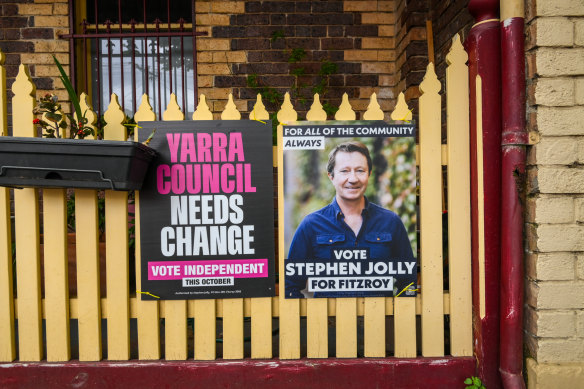
The net loss of eight comes after a major structural change between the 2020 council election and this one; the shifting of the majority of Melbourne councils from multi-member wards to single-member wards.
Loading
In the inner city, there were 21 Greens elected in 2020, and that figure remains the same this year.
Raue has analysed six key inner-city council results: Darebin, Maribyrnong, Melbourne, Merri-bek, Port Phillip and Yarra. The results show a swing of 2-3 per cent away from the Greens in Darebin, Melbourne and Port Phillip.
The most concerning result for the party has been a major shake-up to Yarra council; it was declared the first Greens majority council in 2020, with five Greens councillors elected as a voting bloc.
But this election, the party retained just two councillors in the face of a concerted anti-Greens campaign from an “alliance” of independents running under the Yarra For All banner, headed by long-time Yarra councillor Stephen Jolly. Yarra For All picked up four of the council’s nine seats.
Raue noted that this happened despite the Greens’ primary vote in Yarra remaining the same between 2020 and 2024.

Stephen Jolly’s Yarra For All alliance won four spots on Yarra council.Credit: Justin McManus
“It does reflect the voting system change [to single-member wards],” said Raue.
The Greens have also taken a hit in the inner south and south-east: there is no Greens presence at all after losing councillors in the Port Phillip, Stonnington and Glen Eira councils.
But the party picked up a second spot on Boroondara council. Brimbank, traditionally a Labor stronghold, now has a Greens councillor in the ward closest to Maribyrnong council.
The party held steady in Darebin, retaining three councillors. However, Labor rose from one to five seats there and will have the majority.
“[The Greens] lost one area but picked up a different seat to make up for it. If their goal is to win Northcote at the state level, then it’s probably good for them,” Raue said.
The Greens retained two councillors in Banyule and now have a presence in outer suburbs for the first time – picking up a spot on the Frankston and Casey councils. In Dandenong, where it already had one councillor, it now has two. The party elected councillors for the first time in regional areas such as Bass Coast and Mount Alexander, but they lost a spot in Ballarat.
In the City of Melbourne – which operates under an entirely different electoral system to the state’s other 78 councils – primary votes for the Greens dropped, but the party came in second to winning ticket Team Nick Reece on both the primary vote and after preferences.
Loading
But of the 11 City of Melbourne councillors, only one will be Green, down from two, as Olivia Ball was re-elected but Rohan Leppert retired.
Drawing parallels between council elections and state and federal elections can be dubious as the systems are very different. As The Age has highlighted, party membership is not printed on council ballots and candidates are under no obligation to reveal party membership.
While the Greens openly endorse their local council candidates, they compete against many candidates claiming independent status.
“Therefore, those partisan trends are hard to detect,” Raue said. “And you don’t know if the voters know as well.”
Start the day with a summary of the day’s most important and interesting stories, analysis and insights. Sign up for our Morning Edition newsletter.



























